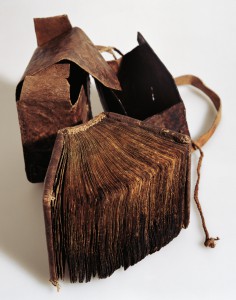“People say that nobody knows what a book is any more. It is observed that people sit on trains, or buses and in waiting rooms and where a few years ago they would have been reading a book, they will instead be consoled at their phone doing some data processing. This might be the case, but perhaps no one has ever really known what a book is, because the book has always been changing. Today the book is again bursting its bounds, becoming a point of mediation, swallowing other media systems and forms of knowledge while fragmenting and migrating into new forms.
[…]
One consequence of the massive amplification of symbol processing made possible by electronic computing, exemplified in its early ability to crack codes, and a quality that became a regular marvel in the era in which computers were thought of as “electronic brains”, is that the book exceeds its bindings. At the same time, as this amplification occurs, habits and media behaviors that have been inculcated and intensified by books as media, migrate into other forms and systems. Whilst certain strands of the “Digital Humanities” have simply seen fit to work on the “digitization” of books, making scans and text corpuses available with tools for their analysis, as if the book is essentially unchanging and originally separate from digits, others such as Andrew Piper, Lori Emerson, Amy Spencer and Hanna Kuusela are busy tracing the way in which as they come into combination, both computers and books change. The deep imbrication between books and computational forms is in turn part of a wider set of fields of co-evolution that come to bear force upon and work their way into the book.

Guttorm Guttormsgaard’s archive is full of books that are entangled with other processes of object formation. Some are magnificent comings together of different orders of objects – like the Ethiopian Coptic Bible with its rucksack. In the present day, other currents and kinds of movement intercept and remobilize the book’s constituent forms. As we see books entangling with computational structures and entities we can perhaps see them undergoing a further transition: incunabula, codex, book, stack, queue, heap. We can go on – lists, tables, interfaces, windows, fields – the shape and modus operandi of the book is mobilised as a conceptual scaffold into manifold combinations. The book is an essentially shifting, capacious form – there is not one aspect of its characteristics concerning binding, titling, authorship, typesetting, pagination, orthography, and so on, that has not been exceeded, gone beyond or done without in various and numerous cases. Books are also interspersed with other operations that exceed their bounds, scanning, analyzing, forming into corpuses, but they still hang together. We can say then that the book is a diagram: a schematization of parts, a way of doing things and of thinking and experiencing that manifests differently in relation to different historical, material, aesthetic and economic dynamics. This loose swarm of characteristics, each of which has their own genealogy, is massively internally differentiated, and generative. Some of these characteristics recede or come to the fore at different moments, coming into combination with others and mutating their characteristics as they do so. Others will stay remarkably resilient across times and across the different manifestations of the book.”
Excerpt from Matthew Fuller: “Nobody knows what a book is anymore.” Forthcoming in Report 3 from the Gutenberg Galaxy (Blaker, 2015).